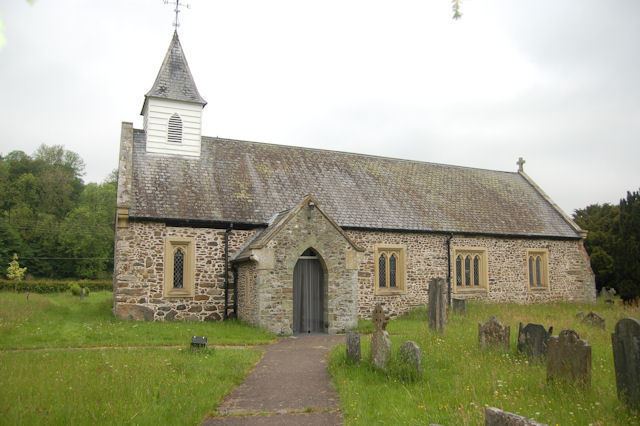Population 294 Community Manafon Sovereign state United Kingdom Local time Sunday 6:11 PM | OS grid reference SJ10SW24 Country Wales | |
 | ||
Weather 11°C, Wind SW at 23 km/h, 94% Humidity | ||
Manafon is a "small rural parish located in the hills of Montgomeryshire, the Northern part of the Welsh county of Powys [formerly Montgomeryshire]. The Parish focuses on the valley of the River Rhiew that runs east to west into the River Severn". The community of Manafon consists of "two main villages within about a mile of one another, Manafon and New Mills. The remainder of the population lives in scattered farms and dwellings and in the small rural settlement of The Green."
Contents
- Map of Manafon Welshpool UK
- Manafon in 1833
- St Michaels Church
- Notable vicars
- Music album Manafon
- References
Map of Manafon, Welshpool, UK
The village is 8 miles (14 km) from Welshpool, 78.4 miles (126.2 km) from Cardiff, and 155.3 miles (249.9 km) from London.
In 2011 the population of Manafon was 294 with 18.4% of them able to speak Welsh. Between 1841 and 1901 the population declined from 795 to 501.
The name was recorded in 1254 as Manauon with Mannavon in 1338, and "the modern spelling first appears early in the reign of Elizabeth, c.1566." Experts now suggest that it means "the ‘plain associated with Anafon’, where the first element is Welsh ma meaning ‘plain, field or place’ and the second a personal name", rather than afon meaning ‘river’, as in Stratford-upon-Avon, which was the earlier view.
Manafon in 1833
From A Topographical Dictionary of Wales by Samuel Lewis, 1833:
St Michael's Church
St Michael's and All Angels Church is an active Anglican church in the parish of Llanfair Caereinion, Llanllugan and Manafon, built in stone with slate roof. The church has been designated by Cadw as a Grade II* listed building. There is documentary evidence relating to a church on the site in 1254 and 1291 but otherwise nothing is known of its history until it was restored in 1859.
And in 1869 Glynne wrote that "this church has been so completely renovated, as scarcely to retain any ancient features".
Notable vicars
Notable former vicars include the poets Gwallter Mechain and R. S. Thomas.
Gwallter Mechain (Walter of Mechain) was the bardic name of Walter Davies (1761 – 1849), who was a Welsh poet, editor, translator, antiquary and Anglican clergyman, born Llanfechain, Montgomeryshire. He went studied at Trinity College, Cambridge, where he received his MA in 1803. He was then awarded the living of Llanwyddelan and in 1807 became vicar of Manafon, where he remained for 30 years and did most of his literary work.
Davies was closely associated with the London Welsh, especially the Gwyneddigion Society, and the revival of the Cymmrodorion Society in 1820. He was a keen supporter of eisteddfodau, where he won many prizes, and he played an important role in establishing provincial eisteddfodic societies.
R. S. Thomas (1913 – 2000) was rector of Manafon from 1942 to 1954. It was during his time in Manafon that he first began to study Welsh and that he published his first three volumes of poetry, The Stones of the Field (1946), An Acre of Land (1952) and The Minister (1953). Thomas's poetry achieved a breakthrough with the publication, in 1955, of his fourth book, Song at the Year's Turning, with an introduction by poet John Betjeman. This, in effect a collected edition of his first three volumes, was critically very well received.
Music album Manafon
Manafon is a 2009 album by David Sylvian. It is an avant-garde work combining elements of free improvisation, experimental rock and chamber music. It reached rank No. 6 in the The Wire's list of best 2009 albums. This album was inspired by the Welsh poet R. S. Thomas.
